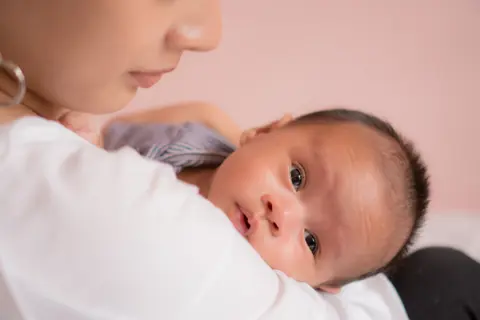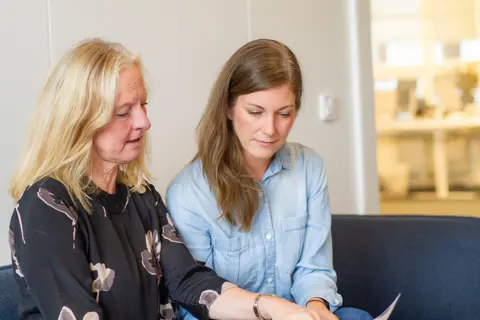
Gerard Ross
Head of Global Communications, UMC

Illustration: Shutterstock
New collaborations are seeking better safety knowledge for pregnant and breastfeeding women.
Sara’s mother suffered from epilepsy, which she managed with medication. When she became pregnant with Sara, the advice from her health providers was mixed and incomplete. Her midwife told her to stop the medication because of the risk of harm to her foetus. Although untreated epilepsy puts both the foetus and mother at risk, she followed the advice. Soon after, an ultrasound revealed she was carrying twins. At a specialist facility, she was now told the risk from seizures was too high, so she resumed her treatment.
“Then, at week 34 of the pregnancy, my twin sister died,” Sara says.
The heartbreaking reality is that miscarriages and congenital anomalies can be caused by many different factors. Compounding the tragedy for the mothers, it is often impossible to know exactly what the cause was or whether they could have prevented it.
“I was always told that it was not because of the medication,” Sara says. “But if no one knows why my sister died, how can they be sure it was not the medication?”
Now, 33 years later, the trauma of her mother’s dilemma and the loss of her never-born twin haunt Sara as she starts her own family. When she became pregnant, she began to suffer from anxiety. Her doctor suggested antidepressants, but she refused. Sara was unwilling to take medicines during her pregnancy if there was any doubt about their safety.
For Sara, and countless pregnant and breastfeeding women around the world, finding clear statements about the safety of many drugs – even common ones – remains surprisingly difficult.
Any history of modern pharmacovigilance invokes the story of thalidomide, recalling the physical harms to babies and the emotional toll on mothers forever haunted by the knowledge that a pill they had taken had harmed their child. It’s a powerful cautionary tale, reminding us that any medical intervention capable of good carries the potential for harm, that safety is never absolute, and there can be no confidence without vigilance.
Accounts of the thalidomide investigation frequently cite the 1961 letter to The Lancet by Dr William McBride. In a little more than 100 words, McBride set out his clinical observations – defects “resulting in polydactyly, syndactyly, and failure of development of long bones”. In plain language, he then asked, “Have any of your readers seen similar abnormalities in babies delivered of women who have taken this drug during pregnancy?”
If pharmacovigilance were to have a holy relic, surely this brief letter would be it. It’s as mythic to the field as Newton’s apple or Fleming’s mouldy Petri dish. Likewise, as the origin story of pharmacovigilance, the thalidomide narrative is both powerful and compelling, with a hero, a villain, and a satisfying ending. Observation, curiosity, and communication combine to form all the excipients of pharmacovigilance.
But another legacy of the thalidomide case is too often lost in the mythology – one that involves the central characters of the story. And the irony of the prolonged invisibility of pregnant women and their offspring reveals a hole in the protective wall of pharmaco-vigilance. Important new activities and collaborative projects aim to fill that hole.
“Despite growing awareness that ethnicity and gender are important factors in treatment outcomes, women in general have historically been underrepresented in trials.”
Much has been written about the lack of representation in clinical trials and its implications for ethical and scientific standards. Failing to select appropriately diverse trial populations can mean failing to gather adequate data about the effects of new drugs on diverse subgroups. Despite growing awareness that ethnicity and gender are important factors in treatment outcomes, women in general have historically been underrepresented in trials. Furthermore, for the overwhelming majority of drugs, pregnant or breastfeeding women are entirely unrepresented.
Studies of representation typically identify a range of biases among researchers. The 2016 paper “Women’s involvement in clinical trials: Historical perspective and future implications” summarises the main historical justifications for excluding women in general. In some cases, say the authors, predominantly male researchers display an unconscious bias, failing to include women because they simply did not think about representation in their test population or did not believe it was relevant. Others display more deliberate, paternalistic bias, believing for example that women are not suitable subjects for scientific study, or that women’s menstrual cycles would complicate the results – as if hormonal variations in therapeutic response might not be clinically relevant knowledge. Yet others display a more well-meaning, though still problematic, attitude that trialling drugs on women of childbearing age is inherently risky.
Since the shockwave of the thalidomide crisis, a legacy of often unconscious bias against including women has swung towards a more conscious and deliberate bias for excluding them, especially if they are pregnant. On its face, this feels entirely understandable. But being cautious of exposing foetuses to harm does not stop their mothers from getting ill. Pregnancy is not a miracle cure that resolves chronic conditions upon conception. Viruses, bacteria, and pathogens do not take a back seat to gestation. Tumours and epileptic seizures will not wait until a baby is weaned.
“Pregnancy is not a miracle cure that resolves chronic conditions upon conception.”
“Historically, for ethical reasons it has been very difficult to include pregnant women in clinical trials,” says Mats Hansson, professor and director at Uppsala University Centre for Research Ethics and Bioethics. “The obvious reason is that it is not only the health and welfare of the pregnant woman herself, but also the foetus – who can’t consent. But the practical effect of that is that you expose women to increased levels of risk because you are lacking scientific evidence.”
In Europe today, it’s estimated that only 5 per cent of the medicines on the market come with adequate safety information for their use during pregnancy or breastfeeding. Yet around 90 per cent of pregnant women are prescribed some form of medication during their pregnancy. In other words, the practical outcome is that pregnant women are stuck with off-label treatments.
Classical ethical paradoxes often pit actions against omissions. We tend to feel more responsible for what we do than for what we allow. But that calculus doesn’t matter to those who are harmed. And just how much harm do we allow to happen when we fail to test medicines on subgroups who will most definitely need to use them?
“There is always a balancing,” Hansson says, “an ethical cost of including pregnant women in trials, but an ethical cost in not including them.”
Guidelines for clinical trials have evolved as regulators grapple with the evolving ethical debates. For example, in the US, the FDA’s post-thalidomide guidelines excluded women of childbearing potential from most early-phase trials of drugs. In the years since, the FDA eased the blanket ban, allowing inclusion in more trials. It now mandates that trial data should better represent real-world populations and it recently released draft guidelines for how to include pregnant and lactating women.
For some, even this progress is not enough. Researchers from the Second Wave Initiative at the University of North Carolina Center for Bioethics, for example, frame the debate as one of basic justice, arguing that if drugs are to be used on a population, then it is unjust to exclude that population from trials. They specifically advocate including pregnant women in clinical trials unless there is a strong reason to exclude them.

“'How is it even possible to make a choice' Sara asks. 'How can you make an informed decision if there is not enough information?'”
Even a perfectly representative clinical trial, however, could not eliminate all safety concerns. There are practical limits on the number of people that can be included, meaning that some rare adverse drug reactions (ADRs) will not occur during trials. Likewise, pre-market trials generally won’t detect ADRs that take
a long time to manifest, such as intellectual impairments that may go unnoticed until later in infancy.
Sara’s boy is now a healthy, energetic 10 months old. But Sara was recently diagnosed with ADHD. For her, hyperactive and compulsive behaviours complicate the already challenging task of caring for her first baby.
A psychologist pointed Sara to drugs that could help modulate
her condition but advised her to wait until she had stopped breastfeeding. While this caution made sense to Sara, she had other questions. For example, when she started working again, if she took the ADHD medication after the morning breastfeed, would her body clear it in time for feeding her boy again in the evening?
Sara says that her psychologist simply read information from a computer without genuinely answering her questions. Sara, who lives in Sweden, turned to official government health sites for more information. There, she discovered that the advice she had been given about the drugs in question was out of date, that the official Swedish recommendations had changed, and that there were guidelines available for using those drugs while breastfeeding.
Like so many other women in similar situations, Sara finds herself in a tough position. When specialist health providers are unable to speak with confidence about the safety of even common medicines for pregnant and breastfeeding women, what are these women to do?
Sara now takes a medication for her condition and she says it seem to be helping. She feels she has some more energy and can operate on a steady level, which makes coping with an active baby easier. But the inconsistency of the advice she receives undermines her confidence.
“How is it even possible to make a choice?” Sara asks. “How can you make an informed decision if there is not enough information?”
Medicines enter the market with safety labels that, more often than not, leave pregnant or breastfeeding women – and their clinicians – in the dark. While some patients are able to abstain from some or all of their medicines throughout pregnancy, for others, the known risk of an untreated condition outweighs the unknown risk of an untrialled drug.
It’s here that we circle back to pharmacovigilance and its post-market surveillance methodologies for identifying potential harms. The WHO Programme for International Drug Monitoring led to the creation of a global network of national pharmacovigilance centres tasked with building systematic databases of suspected ADRs. There are now 136 full members of the WHO programme and 30 associate members gathering information on drug safety.
However, the amount of pharmacovigilance activity specifically related to pregnancy and lactation remains low. In 2018, the Netherlands Pharmacovigilance Centre Lareb surveyed 172 national pharmacovigilance centres around the world about their pregnancy-specific activities. Of those, 40 per cent responded, with most reporting that they received limited numbers of ADR reports related to in utero drug exposure. And while most centres reported they intend to implement or improve pregnancy-related reporting or signal detecting activities, only 13.5 per cent currently do signal detection in pregnancy cases.
“The biggest problem is we don’t have enough research on the safety issues in pregnancy,” says Agnes Kant, managing director of Lareb. “A lot of discussion of pharmacovigilance started with thalidomide. Reporting started after this issue, but safety research in pregnancy did not develop. We have a very good system of safety of medicines in general, but with pregnancy issues we're not there yet.”
“We have a lack of information, we have a lack of research, we have a lack of data on safety in pregnancy,” she adds.
Because data is scarce, sharing the data that does exist is critical. In this respect, Uppsala Monitoring Centre plays a central role, administering VigiBase, WHO’s global database of medicine safety reports. UMC research pharmacist Lovisa Sandberg notes, however, that a challenge in current pharmacovigilance is identifying pregnancy as a factor within large datasets of individual case safety reports.
“In spontaneous reporting systems, key information on the pregnancy is not consistently recorded, so we need improved methods for capturing valid pregnancy reports in a systematic way to use these sources to their full potential,” Sandberg says.
“However, it’s worth noting that in our assessments of case series on pregnancy-related events, we have found reports in VigiBase that are surprisingly rich in describing these events, particularly when narratives are available.”
Encouraging more richness in reported case narratives is, therefore, important. Pregnant women are not just temporarily larger versions of regular patients. In pregnancy, the body undergoes myriad changes, affecting the metabolism of drugs or the response to vaccines. Changes in body weight, organ function, hormonal balance, and immune systems are all potentially relevant factors in understanding the effects of medicines at regularly prescribed doses. The challenge is bringing together other data sources that could lead to more comprehensive analyses.
Some countries have pregnancy registries, for example, but few have close ties to national pharmacovigilance centres. In fact, Lareb’s own close relationship with pREGnant, the Dutch pregnancy registry, was an outlier in the survey they carried out. The survey report notes that the data from pregnancy registries could allow cohort-event monitoring and case-control surveillance, combining “the strengths of the pharmacoepidemiological as well as the clinical PV approach of drug safety surveillance”.

“We need more information and we need to be very careful that we don’t start creating scare stories.”
“The general post-marketing surveillance system is well developed.
But the safety of drug use during pregnancy requires a distinct approach. It needs extra tools and expertise – and a lot of pharmacovigilance institutions don’t have this expertise,” said Kant.
Several collaborative efforts are now underway to forge multi-disciplinary relationships that combine diverse sources of both data and expertise to improve safety knowledge.
One such effort is EUROmediCAT, a European research consortium that grew out of the European Surveillance of Congenital Anomalies (EUROCAT) – a network of congenital anomaly registries. EUROmediCAT aims to create a European system for evaluating and monitoring reproductive safety issues for post-market drugs.
“Everything has to be collaborative,” says Joan Morris, president of EUROmediCAT, explaining that more research now involves working across different data sources, including VigiBase, to examine medicines safety during pregnancy.
“VigiBase is interesting because there haven’t yet been many studies done there looking at congenital anomalies,” she says. “But we’re now looking at how it compares to EUROmediCAT and whether it can be used more.”
But bringing together data sources does require care, cautions Morris, and researchers need to understand the types of data they’re using to ensure the validity of the medicine safety signals they identify.
“If they’re not true signals, it causes an awful lot of anxiety in women. We’re always concerned about them taking medicines that are safe, but equally, we need to consider women not taking medicines because they are afraid. We need more information and we need to be very careful that we don’t start creating scare stories.”

Combining ADR databases with other information sources, such as pregnancy registries and biobanks, can help build a more complete picture. “But it requires experts from all fields. We get data from everywhere, but we also need experts – the clinicians, the statisticians, the epidemiologists – to all work together to evaluate the evidence,” Morris says.
On this point, UMC researcher and team manager Kristina Star describes the collaboration that has been set up between UMC and EUROmediCAT as being of great value to both organisations.
“We contribute with long experience in screening large datasets to detect signals and in further assessing the findings in-depth. Likewise, we are able to draw on EUROmediCAT’s wealth of knowledge of teratogenic issues,” Star says.
Another major international project expanding drug safety knowledge for pregnant and breastfeeding women is ConcePTION, a public-private partnership funded by the Innovative Medicines Initiative (IMI) and bringing together 88 organisations across 22 countries. ConcePTION aims to unify multiple data collections and apply big-data techniques to develop more information about how medications affect pregnancy outcomes. ConcePTION is also incorporating biobank analyses with other sources such as electronic health records and pregnancy registries to build better models of drug transfer into breast milk.
Bioethicist Hansson also leads ConcePTION’s biobanking activities at Uppsala University. He explains the need for tight integration and cooperation.
“If you’re going to do biobanking, you need to have a good relationship with the clinicians, the doctors, and the hospital.”
He says collaborations like ConcePTION rely on establishing systematic protocols for collecting, storing, and analysing samples. This opens a powerful range of analytic approaches. For example, he explains how at one level it’s possible to look into how a drug metabolite behaves in a specific culture. “But then you can also do population-based pharmacokinetics, where you see the effects of this within a population. If you have large enough populations, you can look into how different subpopulations behave regarding the drug,” he says.
The challenges to projects of this nature are not only technical and scientific – they also include ethical and policy considerations. For example, because many congenital anomalies are rare, any single database may have only a small number of records. Sharing them can create a more meaningful dataset, but national policies on data sharing are complex and varied. Likewise, samples in biobanks can provide detailed drug exposure information, but sample retention restrictions in some jurisdictions may lead to data being lost before a signal is detected.
Projects like EUROmediCAT and ConcePTION are beginning to bring together the pieces necessary to ease the frustration and anxiety faced by pregnant and breastfeeding women. The ultimate aim is to develop common data models where researchers can use data from pregnancy registries, reporting systems, and teratology information services for signal detection.
“We want to bring all these systems together and look at how we can detect safety issues, not only from the reporting system, but also from other areas,” says Lareb’s Kant.
For women like Sara, gaining more informed confidence about the safety of the medicines they need – rather than enduring anxious uncertainty about the risks – could make a huge difference. Pre-market trials may always struggle to include pregnant and breastfeeding women. But there is now an opportunity to build a more representative, more patient-centric pharmacovigilance approach.
Read more:
Want to hear more?
Listen to this article as an episode of the Drug Safety Matters podcast
Despite focusing on different species, human and veterinary pharmacovigilance share many goals and approaches, offering opportunities for mutual enhancement of the two disciplines.
06 November 2025
From software updates to complex human-machine interactions, medical devices pose safety challenges that require dedicated frameworks beyond drug vigilance.
28 August 2025
Counterfeit drugs threaten millions worldwide, yet healthcare workers often lack training to spot fakes or report them, leaving this problem largely invisible.
01 October 2025